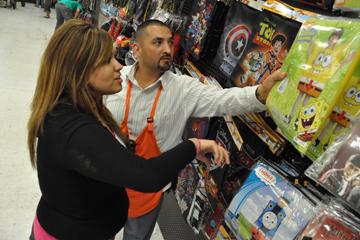Halloween is typically associated with costumes, candy, horror and trick-or-treating, but the pre-Christian Celtic holiday has been traced to have begun 2,000 years ago.
The Library of Congress in its online collections describes the event as the biggest and most significant holiday of the Celtic year. The Celts were known for worshiping nature, the Sun God and Samhain, the lord of the dead.
The Celtic believed that during Samahain now known as Halloween, the lord of the dead could blend with the living. The Celtic gathered sacrificed animals, fruits and vegetables to help strengthen the Sun God. They would also light bonfires to help the dead through their journeys.
Celtic year became Hallowe’en when Christianity spread and the Celtic underworld became the Christian Hell.
Halloween has now contributed to a boost in market sales. The National Retail Federation estimates that shoppers will be spending about $7 billion on Halloween this year. In 2005 Americans spend $3.3 billion.
The National Retail Federation estimates that this year 161 million Americans will celebrate Halloween.
Economics professor Sean Alley said that since the peak of the recession in 2009, spending on things such as costumes has increased.
Fresno State student Thomas Nichols is one of many college students shopping for a costume on a budget this year.
Alley added that the amount of money consumers spend reflects the status of the economy.
“When people make less money they cut out extra things like buying costumes, “ Alley said. “Now that unemployment rates are going down, people with jobs can buy costumes.”
However, Fresno State student Thomas Nichols is one of many college students shopping for a costume on a budget this year.
“I’m going to make my costume,” Nichols said. “I’m dressing up as Mr. T.”
Nichols said his costume consists of an old Navy shirt, a chain he bought from The Home Depot, which he spray painted gold. His total cost was about $10.
Halloween stores such as Halloween Express and other merchants begin preparing months in advance. In January, Halloween vendors met in Houston for a four-day Halloween show.
“The billions of dollars being made will help generate income, jobs and tax revenue,” Alley said.
Betsy Behlen, owner of the Fresno Halloween Express, said these trade shows allow them to see the latest costumes, new ideas and props. Bohlen added that this convention gives vendors of every Halloween product the opportunity to show their merchandise.
“If we see something new, we get it.” Behlen said. The Halloween Express storeowners prepared for about 8 months.
“In this economy finding a building isn’t easy,” Behlen said. This year the owners of Halloween Express opened one store to lessen their risks of losing money. The store opened for business as early as Labor Day. The most popular costume this year are accessories in the “create-a-costume aisle” and zombie customs.
Behlen added that the average amount spent on a costume at the Fresno Halloween Express is about $42.
A study done by the National Retail Federation found that 70 percent of 18 to 24-year-olds wear costumes, which is the highest of any age group.
Other students prefer to minimize expenses by not buying costumes. Fresno State student Akliatese Harris says she’d rather not waste money on a costume.
“I’m going to just stay in, eat pizza and watch movies,” Harris said.
Harris added that to enjoy Halloween money does not need to be spent.






